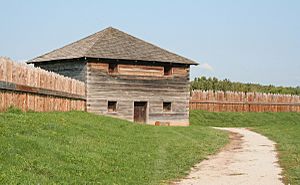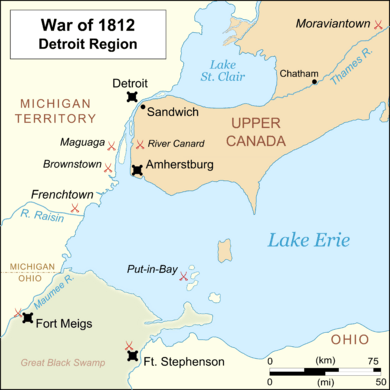Siege of Fort Meigs facts for kids
Quick facts for kids Siege of Fort Meigs |
|||||||
|---|---|---|---|---|---|---|---|
| Part of the War of 1812 | |||||||
 Fort Meigs |
|||||||
|
|||||||
| Belligerents | |||||||
Native Americans |
|||||||
| Commanders and leaders | |||||||
Tecumseh Roundhead |
|||||||
| Strength | |||||||
| 1,250 Native Americans 433 regulars 462 Canadian militia |
1,200 regulars 1,600 militia |
||||||
| Casualties and losses | |||||||
| British 14 killed 47 wounded 41 captured Indians 19 killed and wounded Total 121 |
160 killed 190 wounded 100 wounded prisoners 530 captured 6 missing Total 986 |
||||||
The Siege of Fort Meigs was an important event during the War of 1812. It happened from late April to early May 1813 in what is now Perrysburg, Ohio. British soldiers and their Native American allies tried to capture Fort Meigs. This new American fort was built to stop a planned attack on Detroit. Even though the Americans lost many soldiers in a failed rescue attempt, the British could not take the fort. They eventually had to give up their siege.
Contents
Why was Fort Meigs important?
The War of 1812 began in 1812. Early in the war, the American army, led by General William Hull, surrendered at Detroit. To get Detroit back, the Americans formed a new army called the Army of the Northwest.
General William Henry Harrison soon took command of this army. He later became the 9th President of the United States. Harrison's army faced many challenges, like bad weather and not enough supplies.
Building Forts for Protection
In January 1813, a part of Harrison's army was defeated at the Battle of Frenchtown. After this loss, Harrison pulled his main army back to the Maumee River. He decided to build several forts to protect the rivers and trails. These forts would help his army if they tried to attack again.
Two very important forts were Fort Meigs and Fort Stephenson. Fort Meigs was named after Return J. Meigs Jr., who was the Governor of Ohio at the time.
How Fort Meigs was Built
Harrison arrived at the site of Fort Meigs on February 1, 1813. He had about 4,000 men, mostly citizen soldiers called militia. They started building the fort. However, many of his soldiers' enlistment times ended. This meant they could leave the army.
Harrison had to go to Cincinnati to gather a new army. He left Major Eleazer D. Wood to finish building the fort. The soldiers left behind were not well-clothed. Their enlistments were also ending soon.
The fort was built on the south bank of the Maumee River. It was near the ruins of an old British fort called Fort Miami. Fort Meigs was very large, covering about 8 acres (32,000 square meters). It had a tall fence made of logs, 15 feet high, connecting eight blockhouses. The river protected one side, and deep ditches protected two other sides. The south side was cleared of trees to make it harder for attackers to hide.
British Plans to Attack
Bad weather in early spring stopped the British from attacking while the fort was still being built. The British commander in the Detroit area was Major General Henry Procter. He decided to attack Fort Meigs. He hoped to stop the Americans from preparing for a summer campaign. He also wanted to capture their supplies.
Harrison heard about Procter's plans. He quickly brought 300 more soldiers to Fort Meigs. This made the fort's defense stronger with 1,100 men. He also asked Isaac Shelby, the Governor of Kentucky, to send 1,200 Kentucky militia soldiers. These soldiers, led by General Green Clay, were on their way but did not reach the fort before the siege began.
The Siege Begins
Procter's forces arrived at the Maumee River on April 26. His army included British soldiers, Canadian militia, and about 1,250 Native American warriors. The Native American leaders were Shawnee chief Tecumseh and Wyandot chief Roundhead. Procter also had powerful cannons.
It took several days for the British to set up their cannons. Most of these cannons were on the north side of the river. One cannon battery was set up on the south side. Many Native American warriors were also on the south side, surrounding the fort.
As the British set up their cannons, Harrison ordered his men to quickly build "traverses" inside the fort. These were earth walls about 12 feet high. When the British cannons started firing on May 1, most of their cannonballs harmlessly hit these soft earth walls.
The Battle of the Miami
On May 2, Harrison sent a message to General Clay's approaching forces. He ordered some of Clay's men to disable the British cannons on the north bank of the river. Then, they were to retreat into the fort. At the same time, soldiers from inside the fort would attack the British cannons on the south bank.
Dudley's Attack
Early on May 5, a group of Clay's soldiers, led by Colonel William Dudley, landed on the north bank. This force had 866 men. They surprised the British and stormed the cannons. They managed to disable the cannons, but only for a short time.
However, Dudley's men then lost control. Some of them chased Native American warriors into the woods. Dudley tried to get them back, but it was too late. British soldiers attacked the cannon battery, killing many Kentuckians. In the woods, the disorganized Kentuckians were badly defeated by the Native Americans. Out of Dudley's 866 men, only 150 escaped back to the fort. This event became known as "Dudley's Massacre."
Miller's Attack
On the south bank, the American attack from the fort was partly successful. Colonel John Miller led 350 American soldiers and volunteers. They captured the British cannon battery and took 41 prisoners.
But British soldiers and Native Americans quickly counterattacked. They fought hard and forced Miller's group back into the fort. Many American soldiers were killed or wounded in this fight.
After the Battle
After the battle, the American prisoners from Dudley's group were taken to the ruined Fort Miami. Some Native American warriors began to kill the prisoners. However, Tecumseh and other leaders quickly stopped the killings. Eye-witnesses said that between 12 and 14 prisoners were killed before the massacre ended.
The British called the battle on May 5 the "Battle of the Miami." This was because it happened near the Miami du Lac River, which is now called the Maumee River.
End of the Siege
On May 7, both sides agreed to exchange prisoners. The Kentucky militia prisoners were allowed to go home. They promised not to fight again until they were officially exchanged for British prisoners.
On the same day, Procter's cannons started firing again. But most of the Native American warriors had left the army. The Canadian militia also wanted to go back to their farms. The new bombardment did not do much damage. The fort now had more defenders than the attackers.
Procter gave up the siege on May 9. The Americans lost 160 killed, 190 wounded, and 630 captured or missing during the entire siege.
Second Siege Attempt
After the British left, Harrison put General Clay in charge of Fort Meigs. Clay had about 100 militia soldiers. In July, Tecumseh wanted Procter to try and capture the fort again.
Tecumseh's warriors pretended to attack American reinforcements in the woods. They hoped this would trick Clay into leaving the fort. But Clay knew no reinforcements were coming, so the trick did not work. Procter quickly gave up the second siege attempt.
Images for kids





